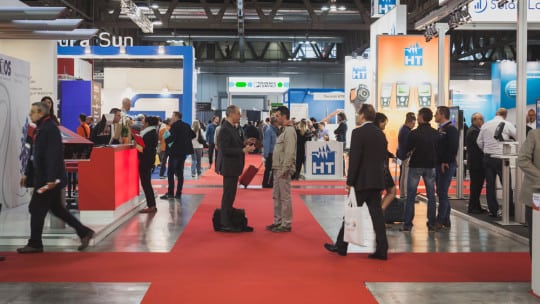
Incorporating trade shows into your broader communications strategy offers invaluable opportunities to elevate your clients' visibility, credibility and market presence. Trade shows serve as dynamic platforms where businesses can directly engage with their target audience, industry peers and key stakeholders in an immersive environment. By submitting your clients for participation in trade shows, you not only amplify their brand exposure but also position them as industry leaders, showcasing their latest innovations, products and services to a captive audience.
Additionally, trade shows provide unparalleled networking prospects, enabling your clients to forge meaningful connections, explore potential partnerships and glean insights into market trends and competitor activities. Integrating trade shows into your marketing plans ensures a multifaceted approach that leverages both digital and physical touchpoints, fostering deeper engagement and driving tangible results for your clients' marketing objectives.
Akin to numerous other gatherings, trade shows faced significant disruption due to the COVID-19 pandemic. While many adapted to virtual or hybrid formats to adhere to health guidelines, several beloved events remained dormant for a few years. Fast forward to 2024, and there is palpable momentum in the industry, with most trade shows having reverted to their traditional, large-scale, in-person formats.
Publicists play a crucial role in enhancing their clients' visibility and achievements at trade shows. For newer communicators and marketers who began their careers during or after the pandemic, the lack of these events meant missing out on valuable firsthand experience in supporting clients and mastering the art of maximizing their impact. As a result, many are now navigating their first trade shows alongside clients, learning as they go.
Here are several strategies you should consider implementing to ensure your next trade show is a success for both you and your client:
Pre-Show Promotion and Planning
Use press releases, social media campaigns and targeted email marketing to announce your client's presence at the trade show. Highlight any new products, services or announcements they'll be showcasing.
Diversify your promotional efforts across various platforms to reach a wider audience. Engage with industry-specific forums and organizations to ensure maximum exposure. Ensure you collaborate with the event organizers as much as possible to secure cross-promotional opportunities for social media and press.
Media Relations
An invaluable tactic to pique interest in your client’s participation at any event is to announce news or give a presentation that will be exclusively released at the event. Tease the announcement in pre-show press releases, social posts and media alerts.
Reach out to relevant industry journalists, bloggers and influencers to schedule interviews, demos or product reviews during the trade show. Provide them with press kits and exclusive access to your client's booth or events.
Research media that have covered the event in the past, and ensure they are included in your pitching. If your client is accepted as a speaker or event sponsor, many event organizers are happy to provide a media list of journalists or publications who will be in attendance to help direct your outreach.
Offer key journalists and influencers unique insights or early, exclusive access to content that aligns with their audience's interests. Personalize your pitches to demonstrate how your client's offerings can provide value to their readers or followers.
Booth Design and Presentation
Collaborate with the client to design an eye-catching booth that embodies their brand identity and effectively showcases their products or services. Ensure that the booth layout encourages engagement and interaction with attendees. If it’s within budget, consider something unique to offer at the booth such as a free headshot. This way you can ask for their name, company and email to share the picture and they receive something valuable in return with the potential to re-engage via email marketing.
Schedule live product demonstrations or presentations of their services in action and educate attendees about their unique value proposition. Encourage audience participation, hands-on exploration and interaction to deepen engagement with your client's offerings.
Networking Opportunities
Arrange meetings with key industry contacts, potential partners and existing clients before and during the trade show. Facilitate introductions and networking opportunities to help your client expand their professional network and foster valuable relationships.
Ensure that there are designated representatives from the company that are equipped to answer questions in these meetings. For example, if someone from your comms team is presenting a session at the event, also bring a member from the sales team or who can be equipped to take prospective new business meetings, or a member of the development team to lead demos and answer product questions.
If you don’t have a designated booth, work with the event organizers ahead of time to reserve space at the event for these meetings so you have a designated spot. If there isn’t a designated space available, ensure you walk the event floor prior to it starting to find a spot that will give your client privacy, like a nearby coffee shop or lounge area.
Tailor your networking approach to the specific interests and needs of each individual or group. Research prospective contacts in advance to identify common interests or mutual benefits that can form the basis of meaningful conversations.
Content Creation
Produce high-quality content such as videos, blog posts or infographics that highlight your client's offerings and expertise. Distribute this content through various channels to attract attendees to their booth and establish thought leadership in the industry.
Following the event, integrate this content into your other marketing efforts and media outreach to continue to capitalize on the engagement.
By implementing these strategies, communicators and marketers can help their clients stand out and achieve their goals at trade shows, whether it's increasing brand awareness, generating leads or fostering meaningful connections within their industry.
Madi Olivé is a senior account executive at UPRAISE Marketing + Public Relations.
